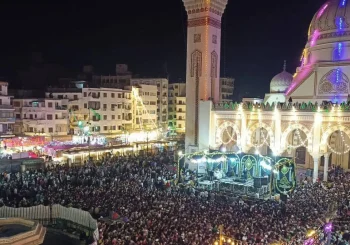In the heart of Zamalek, nestled between the streets of Al Sheikh Al Marsafi and Omar Al Khayam, the Islamic Ceramics Museum stands as a testament to Egypt’s rich artistic legacy.
Recently reopened on Tuesday 15 October after nearly 14 years of closure due to constant renovations, this cultural gem invites visitors to explore its masterpieces free of charge, as shared by one of the dedicated workers at the museum.
The Museum is housed in the Prince Amr Ibrahim Palace, a stunning building commissioned by Prince Amr Ibrahim, a member of the Muhammad Ali dynasty, in 1921.
The palace was designed by Armenian architect Garo Balyan, the youngest member of the renowned Balyan family. Originally, the palace served as a summer residence for Prince Amr Ibrahim and his wife, Necla Sultan.
Combining Moroccan, Turkish, Andalusian, and European classical styles, it creates a picturesque setting for the treasures inside. Each floor of the museum reveals a different segment of history, carefully curated to showcase the evolution of ceramic art over time.

Fatimid Hall: A Glimpse into the Past
The journey begins in the Fatimid Hall, a captivating space that showcases 74 artifacts from the Fatimid era. Particularly intriguing is the colors of the collection of ceramics known as Fayoum ware, which dates back to the 12th century A.D.

As visitors move to the Turkish Hall, they are immersed in the rich heritage of the 16th to 18th centuries. This hall features 96 artifacts, including ornate dishes and elegant jugs, with striking blue and white tiles creating a beautiful contrast.

Egyptian Mamluk Hall: Simplicity Meets Elegance
Next, the Egyptian Mamluk Hall invites visitors to explore 39 unique artifacts from different Islamic periods, including the Mamluk and Ottoman eras. Each artifact reflects the craftsmanship of its time, showcasing intricate calligraphic patterns that highlight the rich cultural heritage.

Ascending to the upper floor, visitors find themselves in the Prince Hall. This elegantly appointed space features a wooden inlaid cupboard and a stunning marble fountain, both reflecting the grandeur of Mamluk and Ottoman design.

A Cultural Hub for All
The Islamic Ceramics Museum is not just a collection of artifacts; it is a vibrant cultural hub that fosters appreciation for Islamic art and architecture. Its reopening marks an important milestone, allowing both locals and tourists to explore Egypt’s rich ceramic heritage.
As the museum continues to educate and inspire, it stands as a testament to Egypt’s artistic legacy. While one art gallery was still closed during the visit, staff members assured that it would reopen in a few months, showcasing Egyptian fine art.
Best of all, entry is free, making it an accessible destination for anyone interested in Egypt’s artistic treasures.







Comments (0)